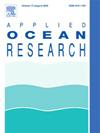波浪数据再分析的全球评估:ERA5数据集与浮标观测的比较
IF 4.3
2区 工程技术
Q1 ENGINEERING, OCEAN
引用次数: 0
摘要
波浪再分析数据对商业、渔业、石油、海上风能、海洋结构的设计和建造等多个行业至关重要。最常用的数据集之一是欧洲中期预报中心开发的ERA5。该数据集的准确性和可靠性尚未在全球范围内进行严格评估。我们根据全球444个浮标的测量结果首次对ERA5有效波高进行了全球评估。我们论证了关键控制因素的影响,包括离岸距离、水深、区域特征和季节性。结果表明,ERA5在极端条件下低估了显著波高。这种低估可能导致在设计船舶或海洋结构基础时低估预测海浪条件的严重性。ERA5精度在离海岸越远的地方越高,但随水深的增加变化不显著。在北半球,ERA5与实测显著波高的RMSE和绝对偏差在夏季比冬季低0.25 m。南半球的季节模式不那么明显。研究结果为ERA5数据的可靠使用提供了全球置信水平,并建立了一种测试未来数据集的方法。本文章由计算机程序翻译,如有差异,请以英文原文为准。
Global evaluation of wave data reanalysis: Comparison of the ERA5 dataset to buoy observations
Wave reanalysis data are critical to multiple industries including commerce, fisheries, petroleum, offshore wind, the design and the construction of maritime structures. One of the most used datasets is ERA5 developed by the European Centre for Medium Range Forecast. The accuracy and reliability of this dataset have not been rigorously assessed on a global scale. We present the first global evaluation of ERA5 significant wave height against measurements from 444 buoys worldwide. We demonstrate the influence of critical control factors including distance to shore, water depth, regional characteristics and seasonality. Results showed that ERA5 underestimates significant wave height in extreme conditions. This underestimation could lead to underestimating the severity of predicted wave conditions when designing vessels or foundations for maritime structures. ERA5 accuracy increases farther from shore, but does not change significantly with increasing water depth. In the Northern Hemisphere, the RMSE and absolute bias between ERA5 and measured significant wave height are up to 0.25 m lower in summer than in winter. Seasonal patterns are less pronounced in the Southern Hemisphere. The results provide global confidence levels for the robust use of ERA5 data, and establish a methodology to test future datasets.
求助全文
通过发布文献求助,成功后即可免费获取论文全文。
去求助
来源期刊

Applied Ocean Research
地学-工程:大洋
CiteScore
8.70
自引率
7.00%
发文量
316
审稿时长
59 days
期刊介绍:
The aim of Applied Ocean Research is to encourage the submission of papers that advance the state of knowledge in a range of topics relevant to ocean engineering.
 求助内容:
求助内容: 应助结果提醒方式:
应助结果提醒方式:


